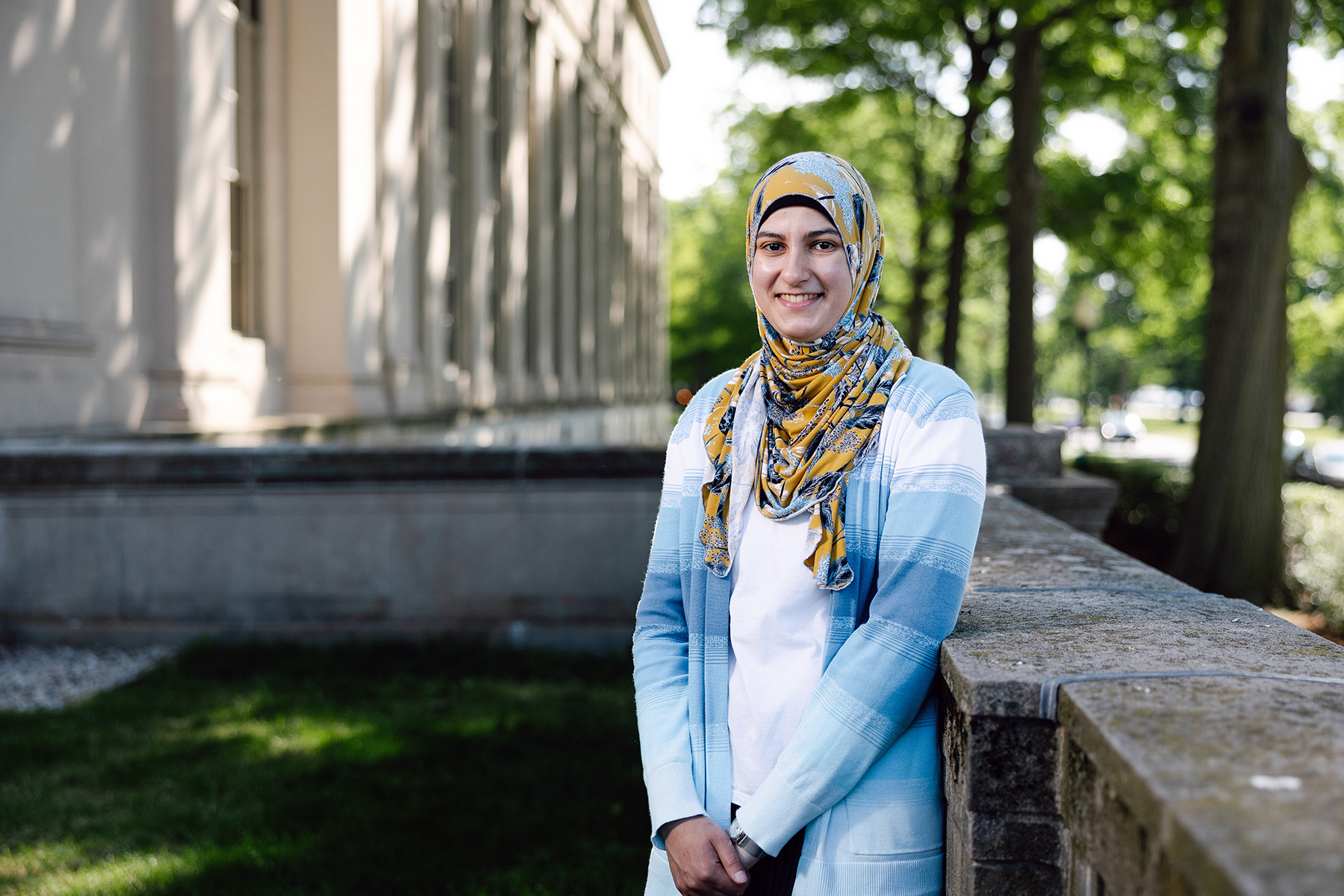Leveraging computational tools to enhance product design
Graduate student Jana Saadi works on making the product design process more creative and inclusive.

As an undergraduate at MIT, Jana Saadi had to find a way to fulfill her humanities class requirements. Little did she know that her decision would heavily shape her academic career.
On a whim, Saadi had joined a friend in a class offered through MIT D-Lab, a project-based program aimed at helping poor communities around the world. The class was supposed to be a quick one-off, but Saadi fell in love with D-Lab’s mission and design philosophy, and stayed involved for the rest of her undergraduate studies.
At D-Lab, “you’re not creating products for people; you’re creating products with people,” she says. Saadi’s experience with D-Lab sparked an interest in the process behind product design. Now, she’s pursuing a PhD in mechanical engineering at MIT, researching how artificial intelligence can help mechanical engineers design products.
Saadi’s path to engineering started from a young age. She grew up in New Jersey with engineers for parents. “My dad likes do-it-yourself projects, and I always found myself helping him around the house,” she says. Saadi loved exercising her creative problem-solving skills, even on small tasks such as fixing an ill-fitting pot lid.
With her upbringing, it was no surprise when Saadi ended up pursuing an undergraduate and master’s degree at MIT in mechanical engineering, with a concentration in product design. But she wasn’t always sure she would pursue a PhD. “Oddly enough, what convinced me to continue on to a PhD was writing my master’s thesis and seeing everything coming together,” she says.
Now, Saadi is working to improve the product design process by evaluating computational design tools, exploring new applications, and developing education curricula. For part of her research, she has even found herself collaborating with D-Lab again. Saadi is currently advised by Maria Yang, a professor in mechanical engineering at MIT and the MIT D-Lab faculty academic director.
Understanding artificial intelligence’s role in product design
When designing products, mechanical engineers juggle multiple goals at once. They must make products easy to use and aesthetically pleasing for users. But they also need to consider their company’s bottom line and make products that are cheap and easy to manufacture.
To help streamline the design process, engineers sometimes look to artificial intelligence tools that help with generating new designs. These tools, also known as generative design tools, are commonly used in automotive, aerospace, and architectural industries. But the impact that these tools have on the product design process isn’t clear, Saadi says, making it difficult for engineers to know how to best leverage them.
To help provide clarity, Saadi is evaluating how engineers use generative design tools in the design process. So far, she has found that these tools can fundamentally change design approaches through a “hybrid intelligence” design process. With these tools, engineers first create a list of engineering constraints for a product without worrying how it will look. For example, they can list where screws are needed but not specify how the screws are held in place. After, they feed the constraints into a generative design tool, which generates a product design accordingly. The engineers can then switch gears and evaluate the product for other goals, such as whether it’s easy to use or manufacture. If they’re unhappy with the product, they can tweak the constraints or add new ones and run them through the tool again.
Through this process, engineers can narrow their focus to “understand the design problem and learn what factors are driving the design,” Saadi says. With generative design tools, engineers can also iterate on designs more quickly, stimulating the creative process as engineers try out new ideas with less effort.
Generative design tools can also “change the design process” by enabling more complex designs, Saadi says. For example, instead of using structures with simple shapes, such as rectangular bars or triangular supports, designs can have an “organic” look that resembles the irregular patterns of coral or the twisted roots of trees.
Before this project, Saadi had little experience with computational tools in the product design process. But that “gave me an advantage,” she says, to approach the process with fresh eyes and ask questions about design practices that might normally be taken for granted. Now, Saadi is analyzing how engineers and tools influence each other in the design process. She hopes to use her research to provide guidance on how generative design tools can foster more creative designs.
Designing cookstoves with Ugandan communities
Saadi is extending the reaches of computational design by looking at a new application: cookstoves for low-income areas, such as Uganda. For this project, she is working with Yang, Dan Sweeney at MIT D-Lab and Sili Deng, a professor of mechanical engineering at MIT.
Affordable cookstoves in low-income areas often release harmful emissions, which not only contribute to climate change but also pose health risks. To reduce these impacts, Saadi and her collaborators are developing a cookstove that uses clean energy but remains affordable.
In the spirit of D-Lab, Saadi is working with Ugandans to tailor the cookstove to their needs. Originally, she had planned to visit Uganda and interview people there. But then the Covid-19 pandemic happened.
“We had to do everything virtually, which had its own challenges” for Uganda, she says. Many Ugandans lack internet access, eliminating the possibility for online surveys or virtual interviews. Saadi ended up working closely with a community partner in Uganda, called Appropriate Energy Saving Technologies (AEST), to collect people’s thoughts. AEST assembled an onsite team to conduct in-person interviews with paper surveys. And Saadi consulted with AEST’s founders, Acuku Helen Ekolu and Betty Ikalany, to ensure the survey was culturally appropriate and understandable.
Fortunately, what started out as a rough-and-ready practical solution ended up being a boon. The surveys Saadi made were multiple-choice, but people often explained their reasoning to the interviewers, providing valuable information that would have been lost in an online survey. In total, the team conducted around 100 surveys. “I liked this mixed survey-interview format,” she says. “There’s a lot of richness that came through [the survey responses].”
Now, Saadi is translating the responses into numerical design requirements for engineers, including herself. For example, “users will say ‘I want to be able to carry my cookstove from outside to inside,’” which means they care about the weight, she says. Saadi must then figure out an ideal weight for the cookstove and include that number on the engineering requirements.
Once she has all the requirements, the team can start designing the cookstove. The cookstove will be based on the Makaa stove, a portable and energy-efficient stove developed by AEST. In the new cookstove design, the MIT team aims to improve its performance to cook food more quickly — a common request by users — while still being affordable, Saadi says. To design the new cookstove, the MIT team plans to use a generative design tool, making this project one of the first uses of computational design for cookstoves.
Reforming design curriculum to be more inclusive
Saadi is also working to improve the product design process through curriculum development. Recently, she joined the Design Justice Project at MIT, which aims to ensure that students are taught to design inclusively for their users. “Education is training designers of the future, so you want to ensure that you’re teaching them to design equitably,” Saadi says. The project is comprised of a team of undergraduate and graduate students, postdocs, and faculty in both engineering and nonengineering fields.
Saadi is helping the team develop instructor surveys to determine if and how they’ve changed their design curriculum over time to include principles of diversity, equity, and inclusion (DEI). Based on the survey results, the team will come up with concrete suggestions for instructors to further incorporate DEI principles in their curriculum. For example, one recommendation could be for instructors to provide students with a checklist of inclusive design considerations, Saadi says.
To help generate more ideas and extend this conversation to a larger community, Saadi is helping the team organize a two-day summit for people working on design education, including instructors from MIT and other institutions. At the summit, participants will discuss the future of design education and brainstorms ways to translate DEI principles from the classroom into standard industry practices. The summit, called the Design Justice Pedagogy Summit, will take place later this month from August 24 to 26.
“As you can see, I’m enjoying this part of my PhD where I have time to diversify my research,” Saadi says. But at the core, “my approach to research is [understanding] the people and the process. There’s a lot of interesting questions to ask.”





































